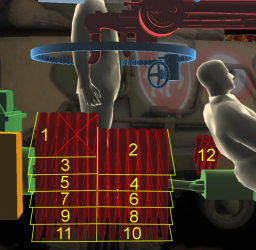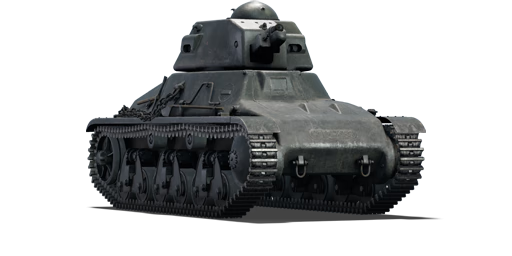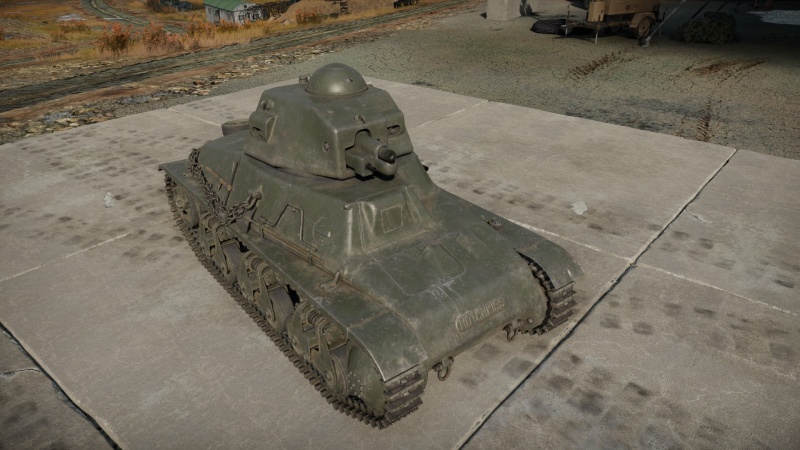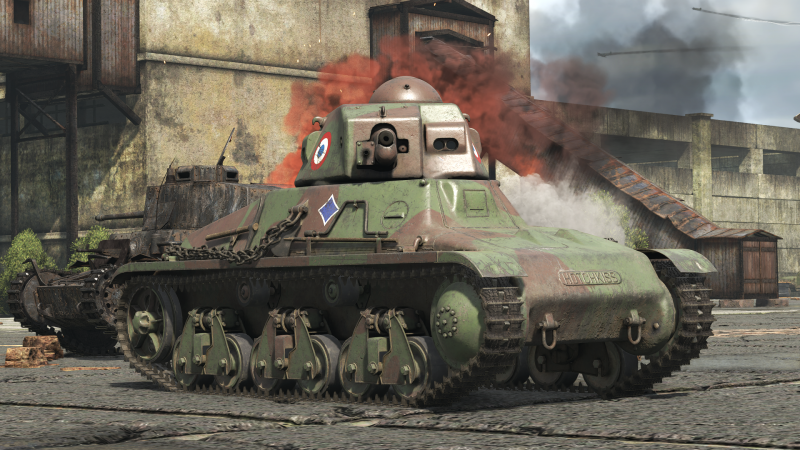H.35
Contents
Description
The Char léger modèle 1935 (Hotchkiss) H is a pre-World War II French cavalry tank. In 1933, it was intended as a low-cost yet well-protected light infantry support tank. The hull was constructed of six bolted-together cast armour parts: the engine deck, the fighting compartment, the front of the hull, the back of the hull, and two longitudinal pieces on the left and right that formed the bottom. Even though the tank was not well regarded by the French Army in general, it was politically unacceptable to stop production. As a result, the first 300 vehicles were offered to cavalry regiments, who were forced to accept them because they would not have been given a budget for other tanks.
Introduced in Update 1.75 "La Résistance", the Char léger modèle 1935 (Hotchkiss) H was possibly the weakest vehicle in the French Army ground forces. Due to its low speed, mediocre manoeuvrability, and subpar main armament that struggles to penetrate most opponents in its rank, players should never use it in any combat in heavily contested zones. It is best utilized as a support vehicle, assisting allies by damaging enemy tanks' tracks and other crucial parts, making them easier to destroy.
General info
Survivability and armour
The armour is decent and it will protect you from incoming long-range shots... but nothing more than that. At close ranges, anything bigger than HMG fire can shred your tank very easily. If you're lucky enough to survive a shot, retreat and ask your allies for help.
Armour type:
- Cast homogeneous armour (hull, turret, cupola)
| Armour | Front (Slope angle) | Sides | Rear | Roof |
|---|---|---|---|---|
| Hull | 34 mm (8-87°) Front plate 22 mm (75-85°) Upper glacis 34 mm (31°) Central glacis 34 mm (30°) Lower glacis |
34 mm (21-33°) Top 34 mm Bottom |
34 mm (31°) Top 34 mm Bottom (7-32°) |
22 mm (11-18°) |
| Turret | 45 + 25 mm (5°) Turret front 45 mm (28-30°) Left side 25 mm (10-19°) Gun mantlet 35 mm (8-25°) View port |
40 mm (1-28°) 35 mm (6-16°) View ports |
40 mm (30°) | 25 mm |
| Cupola | 40 mm (spherical) | |||
Notes:
- Suspension wheels, bogies, and tracks are all 15 mm thick.
- Belly is 8 mm thick.
- Gun barrel is 10 mm thick.
Mobility
| Game Mode | Max Speed (km/h) | Weight (tons) | Engine power (horsepower) | Power-to-weight ratio (hp/ton) | |||
|---|---|---|---|---|---|---|---|
| Forward | Reverse | Stock | Upgraded | Stock | Upgraded | ||
| Arcade | 32 | 6 | 10.6 | 81 | 143 | 7.64 | 13.49 |
| Realistic | 29 | 6 | 66 | 75 | 6.23 | 7.08 | |
With its low speed, don't even dream of bold flanking manoeuvres, you must rely on road and downhills in order to achieve a decent speed. Climbing hills and turning on the spot are also a hard thing to achieve while driving this vehicle. The only thing "light" about this tank is the weight.
Modifications and economy
Armaments
Main armament
| 37 mm SA18 L/21 | Turret rotation speed (°/s) | Reloading rate (seconds) | |||||||||||
|---|---|---|---|---|---|---|---|---|---|---|---|---|---|
| Mode | Capacity | Vertical | Horizontal | Stabilizer | Stock | Upgraded | Full | Expert | Aced | Stock | Full | Expert | Aced |
| Arcade | 76 | -13°/+20° | ±180° | Shoulder | 14.9 | 20.7 | 25.1 | 27.8 | 29.6 | 4.03 | 3.56 | 3.28 | 3.10 |
| Realistic | 9.3 | 11.0 | 13.3 | 14.8 | 15.7 | ||||||||
With only 36 mm of penetration, poor post-penetration damage and a long reload time, this tank's main gun is the main failing of the H.35. With -13° of depression, it is actually a very depressing gun to shoot in a figurative and literal sense.
Ammunition
| Penetration statistics | |||||||
|---|---|---|---|---|---|---|---|
| Ammunition | Type of warhead |
Penetration @ 0° Angle of Attack (mm) | |||||
| 10 m | 100 m | 500 m | 1,000 m | 1,500 m | 2,000 m | ||
| Mle1937 | APCR | 36 | 33 | 24 | 16 | 8 | 5 |
| Shell details | ||||||||||||
|---|---|---|---|---|---|---|---|---|---|---|---|---|
| Ammunition | Type of warhead |
Velocity (m/s) |
Projectile mass (kg) |
Fuse delay | Fuse sensitivity (mm) |
Explosive mass (TNT equivalent) (g) |
Ricochet | |||||
| 0% | 50% | 100% | ||||||||||
| Mle1937 | APCR | 600 | 0.5 | - | - | - | 66° | 70° | 72° | |||
Ammo racks

| Full ammo |
1st rack empty |
2nd rack empty |
3rd rack empty |
4th rack empty |
5th rack empty |
6th rack empty |
|---|---|---|---|---|---|---|
| 76 | 75 (+1) | 68 (+8) | 62 (+14) | 55 (+21) | 49 (+27) | 42 (+34) |
| 7th rack empty |
8th rack empty |
9th rack empty |
10th rack empty |
11th rack empty |
12th rack empty |
Visual discrepancy |
| 36 (+40) | 29 (+47) | 23 (+53) | 16 (+60) | 10 (+66) | 1 (+75) | Yes |
Notes:
- The visual discrepancy concerns the total number of shells as well as the number of shells in rack 1:
- 80 shells are modelled but you can only pack 76 shells, meaning some rounds are never present (crossed out in the picture).
- Rack 1 is modeled as 6 shells but contains only 2 shells.
- As they are modelled by sets of 6, 7, or 9, shells disappear from racks only after you've fire all shells in the set.
Machine guns
| 7.5 mm MAC 31 | ||||
|---|---|---|---|---|
| Mount | Capacity (Belt) | Fire rate | Vertical | Horizontal |
| Coaxial | 2,400 (150) | 551 | N/A | N/A |
The small calibre of the MAC 31 machine gun makes it largely ineffective against all armoured vehicles but the ones with an open compartment. It still can be used to ping targets as a rangefinding help or to mow down minor obstacles blocking your line of sight.
Usage in battles
Playing the H.35 is a hard task. Having such a bad gun, it cannot reliably engage a fight without getting the first shot off; hence, one must stick with its teammates in order to survive an encounter. Never drag attention on yourself since anything bigger than HMG fire will shred you at normal combat ranges (~500 m).
Tactics
Hull down:
Since your turret armour is decent, a good way to use this tank can be to hide the hull behind a rock, a hill or any shell-proof prop and wait for the enemy to fall in your sights. This way, you will either be able to shoot at their weak side or have enough time to aim before they can react to your presence. Ensure yourself to pick a spot near a choke-point such as a capture point or a popular main road.
"Brawling":
In urban maps, narrow streets and crossroad allow for many flanking and close-quarter action: follow your team, always cover behind allied vehicles and don't bother stealing a score from them since it's about the only good shots you will get on an enemy with such a poor vehicle.
Fleeing:
Turn your back to the enemy and use your engine deck as a shield for the crew. Use this tactic anytime you are left alone and go find yourself another teammate. Don't use your reverse speed since it's too low: turn back and flee, your armour is as thick as on the front of your tank. Never stop to try a shot since your pursuers have a way better gun than yours.
Pros and cons
Pros:
- Strong armour for its battle rating
- Good depression angle of -13°
- Thick and sloped turret makes a good hull-down position
- Good coaxial MAC 31 MG
Cons:
- Among the worst rank I ground vehicles: very frustrating to play
- It has the worst APCR-shot in the entire game
- APCR deals only punctual damage: unable to destroy enemy tanks with a single shot
- Reload speed is a little on the slow side for the calibre
- Extremely poor mobility:
- Slow top speed
- Narrow tracks offering poor cross-country capability
- Having only two crew members severely limits survivability, even with crew replenishment
History
Officially known as the Char Léger Mle 1935 Hotchkiss (Hotchkiss Light Tank model 1935), this was a competitor with Renault's R.35 to replace the WWI-era FT-17 as France's infantry tank. While the infantry went with the R.35, the French cavalry adopted the H.35 to serve alongside the S.35 Somua. The R.35 and the H.35 were very similar in construction and visual appearance, with the same turret and the 37 mm SA18 main gun, a tank gun conversion of a 1916 infantry gun. Both tanks also used a cast hull, a novel idea in 1935. As with all French tanks, none were equipped with radios. The H.35, as a cavalry tank was heavier but also somewhat faster than the R.35.
In total 400 of the Hotchkiss model would be built, 300 for the cavalry and another 100 for the 13th and 38th independent tank battalions. Cavalry units equipped with the H.35 during the fall of France included the 4th Cuirassiers, the 11th (Motorized), 13th, 18th and 29th Dragoons, the 1st, 2nd, 3rd and 4th Armoured Car Regiments, and the 5th Divisional Reconnaissance Group, in total comprising 16 squadrons of 16-20 tanks each. Another three H.35s were on trials with the Polish Army at the onset of war in September 1939. They, along with 4 stray R.35s, fought in an ad hoc unit on the Ukrainian front until the fall of Poland.
Another 900 R.35s, using the same turret, the SA18 gun and a very similar hull, were in service in 1940, in 20 tank battalions, making it the most common tank in French service during the war. In total, somewhere between 1,400 and 2,000 of the Renault model would be built. Another 190 of the R.35s were exported pre-war, to Poland (50), Yugoslavia (50), Turkey (50), and Romania (40). Most of those in Polish service was with the 21st Light Tank Battalion, which escaped to Romania without seeing combat; it is unclear how many of the Yugoslav-purchased tanks were even delivered before France fell, but those that arrived served with that country's 2nd Tank Battalion, which saw limited or no action during the 1941 invasion; after that country fell those R.35s would have been turned over to the Romanians as well. The Romanians would upgrade their R.35s with captured Russian 45 mm tank guns and continue to use them through to 1944.
The SA18-armed R.35 also continued in service with Vichy France until 1942 and were used in fighting in Syria and North Africa. Another 124 SA18-armed R.35s were turned over by the Germans to Italy, where they fought and were lost in the invasion of Sicily in 1942. The Germans converted another 174 R.35s to tank destroyers (PanzerJäger), generally armed with 47 mm guns in the place of turrets and used primarily in France and secondary theatres. 110 of these were still in service at the start of 1944. Syria would employ these tanks in the 1947-1949 Palestine War, however they were vastly outdated and were employed more for more of a fear factor than tactical use. They would also later be refit with a QF 2-pounder gun and used in the 1958 Lebanon Crisis and would be the last recorded use of the vehicle.
Media
- Skins
- Videos
See also
- Vehicles equipped with the same chassis
- Other vehicles of similar configuration and role
External links
| Hotchkiss | |
|---|---|
| Tanks | |
| Light tanks | H.35 · H.39 · H.39 "Cambronne" |
| France light tanks | |
|---|---|
| AMC.34/35 | AMC.34 YR · AMC.35 (ACG.1) |
| H.35/39 | H.35 · H.39 · H.39 "Cambronne" |
| AMX-13 | AMX-13 (FL11) · AMX-13-M24 · AMX-13 · AMX-13 (SS.11) · AMX-13-90 · AMX-13 (HOT) |
| Wheeled | AML-90 · AMX-10RC · Vextra 105 |
| AMD.35 | AMD.35 · AMD.35 (SA35) |
| E.B.R. | E.B.R. (1951) · E.B.R. (1954) · E.B.R. (1963) |
| Other | FCM.36 · R.35 (SA38) · Char 25t · MARS 15 · VBCI-2 (MCT30) |
| Austria | SK-105A2 |
| Great Britain | ▄Crusader Mk.II |
| Netherlands | CV 9035NL |
| USA | LVT-4/40 · ▄M3A3 Stuart |






